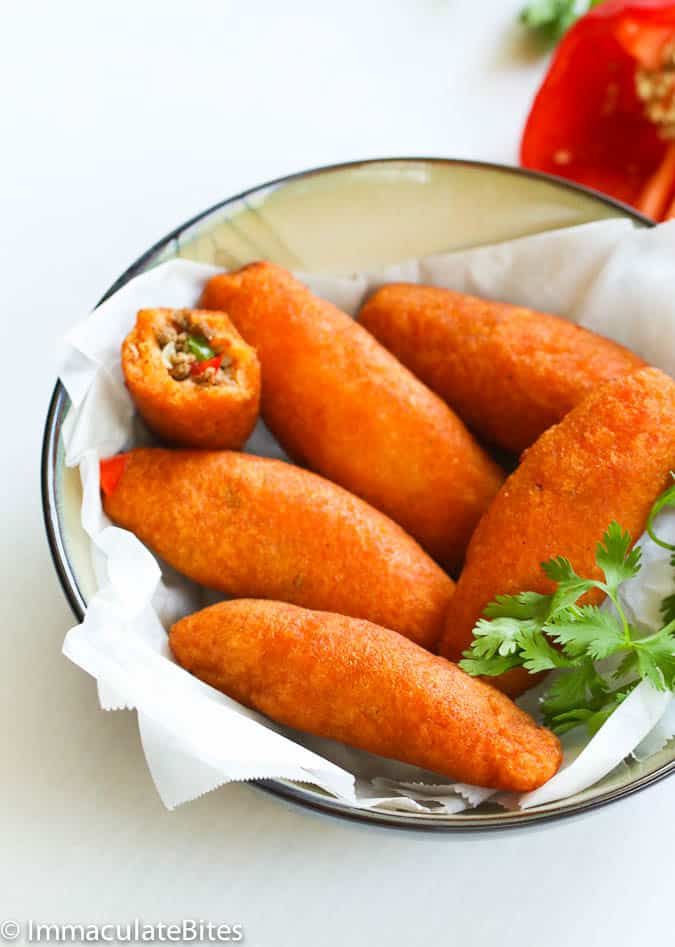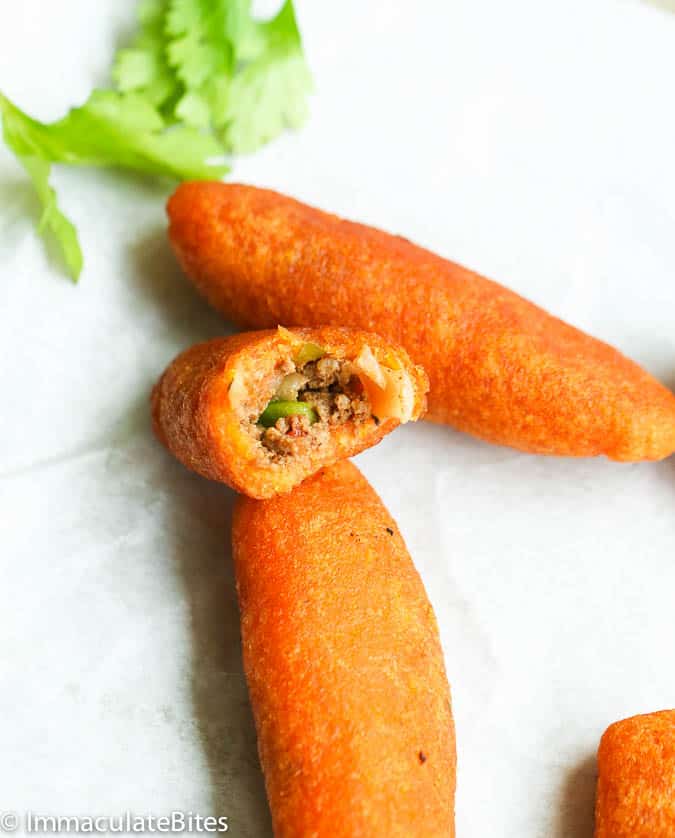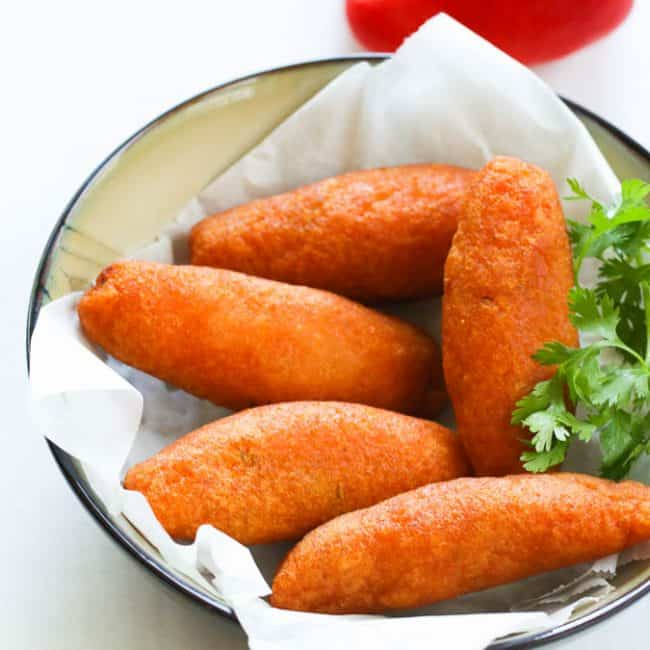Alcapurrias are a tasty traditional Puerto Rican snack. Grated yuca (and maybe some mashed green bananas) stuffed with picadillo (a tasty beef filling) come together for pure heaven. This empanada-like snack is perfect for entertaining!

The first thing that may come to mind when you hear alcapurria wrapped in wax paper is the gorgeous beaches in Puerto Rico. If you’ve ever been there, you know this tasty snack is popular street food with the vendors.
They make THE perfect snack when you want to enjoy the tropics in the comfort of your home. And who doesn’t need a tropical vacation now and then? No need for a trip to Puerto Rico because you can enjoy the tropics right now. Are you ready?

What Makes Alcapurrias Unique?
Okay, daydreaming aside. What I love about fried alcapurrias is their slightly different flavor profile. Every bite is equally delicious and crave-worthy, and get this, the dough is gluten-free. Talk about bonus points for alcapurrias.👏
Alcapurrias also have a beautiful, toasty orange color due to a spice called achiote in the dough mixture. Achiote is a spice from the bija plant, commonly found in the Caribbean. If you want to keep it traditional, grab a packet at any Hispanic market. If you can’t find it, omit it and season it with your favorite seasonings.
Recipe Ingredients
Masa (Dough)
- Yuca – Also called cassava, this slightly sweet root vegetable is also somewhat sticky. You can buy fresh and grate it yourself, or get pre-grated cassava.
- Seasonings – Garlic powder, onion powder, salt, and sazon with achiote are all the flavor you need.
Picadillo
- Ground Beef – The base ingredient for your meaty picadillo. But ground pork, chicken, and turkey will work.
- Flavor – Onion, garlic, tomato sauce, smoked paprika, bell pepper, cilantro, olives, oregano, and sazon deliver the classic Puerto Rican flavor profile.
- Tomato Sauce binds all the ingredients while adding a touch of acidity for a flavor enhancer.
- Canola Oil – for frying.
How to Make Alcapurrias

Masa (Dough)
- Prep the Yuca – Cut off both ends of the cassava (yuca) and then cut them in half. Make a shallow cut into the skin and gradually work your knife under the skin to remove it. Split the yuca in half, then remove the inner woody core in the center and discard it.
- Cut into small chunks and wash immediately to keep them from turning dark. Leave them in cool water until ready to use. (Photo 1)
- Puree – Pulse the cassava/yuca in a food processor until puree, or use a grater to grate it. You may have to do so in batches. (Photos 2-3)
- Mix – Pour it into a large bowl, then add the garlic powder, onion, salt, oil, and sazon. Mix thoroughly and set aside. (Photos 4-5)
Picadillo
- Saute – Add about 2 tablespoons of canola or olive oil in a skillet, followed by onions, garlic, cumin, smoked paprika, cayenne, and oregano. Sweat it for about a minute.
- Veggies – Add tomato sauce and bell pepper, and bring to a simmer. Then add ground meat, and cook for 7-10 minutes while stirring frequently. Pour in a little broth or water as needed to prevent burning.
- Season with salt, chicken bouillon, or sazon. Finally, add olives, green onions, and cilantro, and adjust for seasoning. Remove and set aside.

Assemble
- Scoop about 3 tablespoons of the yuca mixture into the palm of your hand. Then flatten it out until it covers the palm of your hand.
- Fill – Add about 1 tablespoon of picadillo into the center of the dough. Fold it over the filling to enclose it, then gently fold over the dough and roll it out to form a cylinder about 3 inches long. Place on a plate or clean surface. Repeat the process with the remaining dough and filling until you have used up all the dough. (Photo 7-10)
- Heat oil in a heavy, deep pot, saucepan, or skillet over medium-high heat until it registers 350°F (177℃). Add about 3 alcapurria to the hot oil. You could add more but don’t overcrowd the pan so the dough doesn’t soak up too much oil, making it soggy. Repeat until you fry up all your alcapurrias.
- Fry, turning them with a slotted metal spoon, until the outside of the alcapurria is golden brown. The filling is cooked through with an internal temperature of 165°F. It should take 7-10 minutes, depending on the size of the alcapurria. (Photo 11)
- Serve – Remove from the pan with a slotted spoon, and transfer to a paper-towel-lined plate to drain. Serve warm. Repeat with the remaining dough. (Photo 12)

Recipe Variations
- Dough Variations: Green plantains, green bananas, taro root, and yams also make great dough. I do like to use some yuca because it sticks together.
- Filling Swaps: Of course, it wouldn’t be a true alcapurria, but any thick meat sauce will work. You can even make it vegetarian with grated cheese that melts well. Salt cod is also a nice addition.
- Patties: The dough is incredible on its own. Skip the filling and make patties with the dough and fry it up.
- Air Fryer Alcapurrias: If you don’t want a deep-fried snack, air fry them. Assemble them, and then instead of frying them, spray them lightly with cooking oil. Air fry them at 350℉/177℃ for about 15 minutes.
Tips and Tricks
- After you cut the yuca into small chunks, wash them immediately. Then soak them in cool water until you’re ready to use them to avoid discoloration.
- Chill the dough for up to an hour for easier assembly.
- Do not overcrowd the pan when frying. It’ll make the dough all soggy.
- You may assemble all of it in advance, wrap them in plastic and freeze it for future use. Thaw out and toss in the fryer when you want to indulge in these snacks.
Make-Ahead Instructions
Sometimes, we sacrifice just a little for convenience. So you can assemble the alcapurrias ahead and store them in the refrigerator for up to 24 hours. If you decide to fry them ahead, drain them well. Then store them in the fridge for up to four days.
Freezing alcapurrias is a good option. You can assemble and freeze them uncooked for up to 3 months. When ready to fry them, thaw them overnight in the refrigerator and fry them according to the instructions.
And you can reheat leftover alcapurria straight from the freezer. Bake or air fry them at 350℉/177℃ for approximately 15 minutes.
Serving and Storage Instructions
Alcapurrias are best served hot and crispy!🤤 Serve them with your favorite dipping sauce and go to town!
What’s great about these is you can freeze them for three months. Place them in a single layer on parchment paper so they don’t stick together or get soggy.

FAQs
You can find different recipe variations around the Caribbean. For example, empanadillas (little patties), also called pastelillos, are very popular. They also feature deep-fried dough stuffed with a beef picadillo. And rumor has it that they descended from kibbeh.
Alcapurrias and pasteles have similar ingredients. What varies is the method of assembly and preparation. While you fry alcapurrias, you steam pasteles in banana leaves. Alcapurrias are basically the summer version of pasteles.😁
Any Hispanic market in the States should carry achiote. If you can’t find it, don’t worry. Sazon Goya has a similar taste. You can also use turmeric or smoked paprika for color.
What to Serve With Alcapurrias
Alcapurrias are so good all on their own. But they also go well with Thousand Island dressing or better-than-store-bought homemade mayonnaise.
For a full meal, make a fresh pineapple cucumber salad. And take yourself straight to the tropics with a summery piña colada.
More Drool-Worthy Tropical Recipes to Try
Conclusion
Alcapurrias are a must-try recipe if you’re craving authentic Puerto Rican comfort food. Are you hungry for more? Check out what’s new on Facebook.
Watch How to Make It
[adthrive-in-post-video-player video-id=”S0KYMQbx” upload-date=”2023-02-07T11:37:49.000Z” name=”ALCAPURRIAS.mp4″ description=”Alcapurrias are a traditional Puerto Rican snack with grated yuca or both yucca and green banana and then stuffed with picadillo – a scrumptious beef filling.” player-type=”collapse” override-embed=”false”]
This blog post was originally published in August 2017 and has been updated with additional tips, new photos, and a video.
Alcapurrias
Ingredients
Masa (Dough)
- 3 pounds yuca (or cassava)
- 2 teaspoons garlic powder
- 1 tablespoon onion powder
- ½ teaspoon salt
- 1 packet Sazón with achiote
- 2 tablespoons vegetable oil
Picadillo
- 2 tablespoons canola oil
- ½ pound ground meat
- ½ medium onion, chopped
- 1 teaspoon garlic, minced
- ½ cup tomato sauce
- 1 tablespoon smoked paprika
- 1 small green, yellow or red bell pepper
- 2 tablespoons cilantro, chopped
- ¼ cup olives, chopped
- 1 teaspoon oregano
- Sazón to taste
Instructions
Masa (Dough)
- Cut off both ends of the cassava (yuca) and then cut them in half.
- Make a shallow cut into the skin of the cassava and gradually work your knife under the layer of the cassava/yuca to remove the skin. Split it in half, then remove the inner woody core in the center and discard it.
- Cut into small chunks and wash immediately to prevent discoloration, and leave them in cool water until ready to use.
- Pulse the cassava/yuca in a food processor until pureed, or use a grater to grate it. You may have to do so in batches.
- Pour it out in a large bowl, then add garlic powder, onion, salt, oil, and Sazon, thoroughly mix, and set aside.
Picadillo
- Add about 2 tablespoons of oil in a skillet, followed by onions, garlic, cumin, smoked paprika, cayenne, and oregano, and sweat it for about a minute.
- Then add bell pepper and tomato sauce, bring to a simmer, add ground meat, and cook for 7-10 minutes, while stirring frequently to prevent burning burning; add broth or water as needed.
- Season with salt, chicken bouillon, or Sazon.
- Finally, add olives, green onions, and cilantro, and adjust for seasoning. Remove and set aside.
Assemble
- Scoop about 3 tablespoons of the yuca mixture into the palm of your hand. Then flatten it out until it covers your palm.
- Put about 1 tablespoon of picadillo into the center of the dough. Fold the dough over the filling to enclose it, then gently roll it out to form a cylinder about 3” long. Place on a plate or clean surface. Repeat the process with the remaining dough and filling until you have used up all the dough.
- Heat oil in a heavy, deep pot, saucepan, or skillet over medium-high heat. If using a thermometer until oil registers 350°F/177℃. Add about 3 alcapurrias at a time, don't crowd the pan. It may cause the dough to soak up too much oil and make it soggy.
- Fry, flipping with a slotted metal spoon, until the outside of the alcapurria is crisp and the dough inside is cooked through (internal temperature of 165°F), 7-10 minutes, depending on the size of the alcapurrias. Remove from the pan with a slotted spoon, and transfer to a paper-towel-lined plate to drain. Serve warm. Repeat with the remaining dough.
Tips & Notes:
- You can also customize these alcapurrias according to your preference. You may sub the ground beef filling with ground chicken, turkey, stewed crab, or salted cod and still enjoy the same rich and flavorful experience.
- After you cut the yuca into small chunks, wash them immediately and soak them in cool water until you’re ready to use to avoid discoloration.
- Do not overcrowd the pan when frying because it will make the dough soggy.
- You may assemble all of it in advance, wrap them in plastic and freeze it for future use. Thaw out and toss in the fryer when you want to indulge in these snacks.
- Please remember that the nutritional information is a rough estimate and can vary significantly based on the products used in the recipe.

Lenny P. says
My family is from Puerto Rico. This recipe is spot on!
Brings back beach and roadside stand memories for me.
Questions?
In the Masa (Dough) the garlic and onion are minced or powder?
Also I used a deep fryer at 350 degrees and cooked for about 8-9 minutes each. The outside turned out golden but some of the insides remained a little raw. I cooked them from frozen state because I was told that is key to help them keep their form and not fall apart when frying. Any suggestions? I just didn’t want to burn them.
Thanks!
Imma says
For the masa, yes, it’s powdered onion and garlic.
I didn’t freeze them, and they didn’t fall apart. If you feel the need to freeze them before frying, try putting them in the freezer 30 minutes before so the masa is frozen, but the picadillo is not. Hope that makes sense:grin: and please let me know how it goes.
C. Colon says
I like how simple this recipe seems and how it is actually packed with complex flavors.
Immaculate Bites says
Thank you, C. Colon! It’s always great to have simple recipes on hand. Glad you enjoyed this!
Latania Graves says
Loved the recipe but you should put in the instructions to squeeze out the liquid.
Immaculate Bites says
Nice catch, Latania! Thanks, I’ll have this noted. Happy you loved the recipe 🙂
Maya says
Would using frozen casava work for this recipe? Would I need to squeeze out excess liquid from it or need to add an egg or anything for the masa to stay together?
ImmaculateBites says
Yes frozen cassava would work. However..you would have to squeeze out the water.
Christy Berrio says
If you use yucca and plantains for the dough, how much plantains do you use and do you use green or ripe plantains?
ImmaculateBites says
Equal amount of cassava – you can either use green or ripe. The idea is to have a soft dough , which can be stuffed and fried without it falling apart.
claudia says
Hi!
Any idea if I can use taro instead of yucca? I can’t get yucca here…or what would you say is the best substitute? And how long did you leave the dough mixture in the cloth to strain out the liquid? Lastly…any chance I can brush with oil and bake in the oven?
Thanks!
ImmaculateBites says
You sure can. A lot of recipes use taro instead. I let in drain for about 5-10 minutes, depending on the sieve .
Baking this would not have the right texture. It’s chewy . Try baking one and see if you like it, before proceeding with the rest.
Juan says
You can order YUCA in Amazon.com
Nes says
These come from a Middle Eastern/Levantine dish called ‘kibbeh’ that made its way to the Caribbean Islands. They even call it by that name in the Dominican Republic. There are hundreds of variations of kibbeh, not just the type that is made from bulgur.
ImmaculateBites says
Awesome! Thanks for taking time out to share this with us.
Sebastian Wahl says
yo this is awesome. make sure to check out the guyanese cassava puff and the colmbian caramanola, they are similar, but this and the cassava puff are my favorite
Cyn Roatan says
I live in Honduras, and we have 2 kinds of yucca, white and yellow yucca. Which one would be best for this recipe?
Thanks !
ImmaculateBites says
Hi Cyn! The white is best! At least that’s what I used here.